
13 Jan 2025
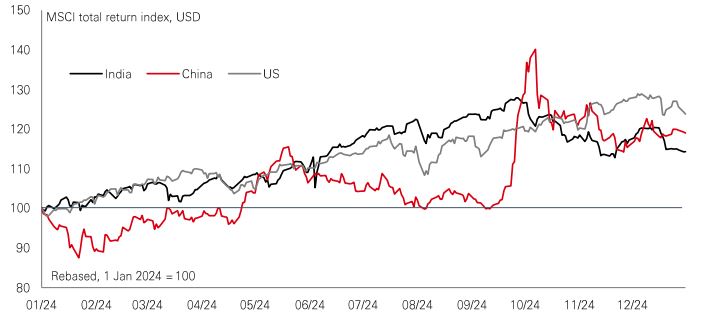
In 2024, central banks cut rates, fiscal policy remained active, and growth stayed resilient. Many assets – especially stocks and precious metals – did very well. Geopolitics mattered a lot for the market narrative. But (apart from gold), it’s hard to see much evidence of it in 2024 investment market returns.
Megatrends were important in 2024. The AI theme powered growth stocks to outperform value. And the prospect of tax cuts and deregulation turbo-charged investor confidence in US stocks (so called “US exceptionalism”). That all meant that the US market outperformed Europe massively – by more than 20 percentage points in dollar terms.
And bonds put in a decent performance in 2024, unless you were invested in Brazil or Japan. Even so, stocks outperformed Treasuries and other core fixed income assets in 2024 because the macro backdrop of no recession, rate cuts, and profits resilience was simply more equity-friendly.
Likewise in emerging markets. Bonds performed reasonably well – with India bonds a highlight. But EM stocks outperformed EM bonds, and the performance of Chinese stocks (outperforming India) was noteworthy (see Page 2). From here, the uncertain macro backdrop looks set to persist in 2025. That’s likely to translate to periods of elevated volatility in markets and calls on investors to do their homework when it comes to asset allocation.
In an unusually uncertain macro environment, making forecasts for the year ahead is even tougher than normal. But here are some of the key macro questions we think will feature heavily in investors’ minds in 2025…
A key question, of course, is which way the narrative on Fed rates will swing next. Could markets even price a Fed hike? And what would that mean for Treasuries, the dollar, and risk assets? Likewise, how will rising policy and geopolitical uncertainty impact trade, global growth, inflation, and investor risk appetite in 2025? With yields rallying at the long end, and signs of term premium rising too, could “bond market vigilantes” play an influential role in disciplining policy makers this year?
And can US exceptionalism keep on going? Will US consumers keep on spending? Can 2024’s market megatrends, like AI, keep on performing? There could be scope for global stock market performance to finally broaden out in 2025, boosting the broader US, European, and Japanese markets. And further policy support in China could be a catalyst to close the valuation discount in Chinese, Asian, and Frontier stocks. There’s certainly plenty for economists and investors to think about at the start of 2025.
The value of investments and any income from them can go down as well as up and investors may not get back the amount originally invested. Past performance does not predict future returns. For informational purposes only and should not be construed as a recommendation to invest in the specific country, product, strategy, sector, or security. Any views expressed were held at the time of preparation and are subject to change without notice. Any forecast, projection or target where provided is indicative only and is not guaranteed in any way. Diversification does not ensure a profit or protect against loss. Source: HSBC Asset Management. Macrobond, Bloomberg. Data as at 7.30am UK time 10 January 2025.
US 10-year US Treasury (UST) yields continued to push higher last week, extending an upward trend that began shortly after the Fed’s first rate cut in September. This defies the textbook crunch lower in yields that usually occurs after the Fed starts to lower rates.
Structural, rather than cyclical, factors appear to be driving the sell-off. Activity data have been in line with expectations and the latest core PCE inflation number was on the low side. To some analysts, the move reflects a mix of markets pricing in a higher neutral policy rate, given the resilience of growth; and increasing concerns about US government debt dynamics.
The base case is that some moderation in US growth and inflation allow the Fed to ease 0.50%-1.00% in 2025, limiting the scope for a significant further sell-off in USTs. However, the situation warrants close attention. As well as weighing on growth prospects and raising financial stability risks, rising UST yields can create problems in other markets. For example, since early December, the equal-weighted S&P 500 is significantly down, while longer-dated UK gilts have underperformed USTs, reflecting the UK’s stretched fiscal position and weak growth.
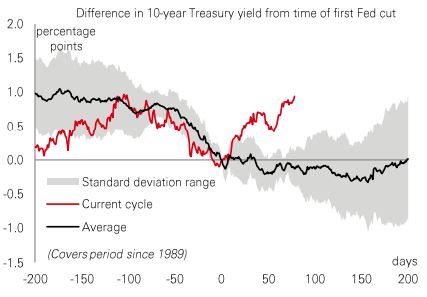
Japanese stocks underperformed global peers in dollar terms in Q4 2024. Potential changes in US trade policy, plus the strength of US stocks and the dollar influenced the performance. Domestic forces were also at play, with uncertainty over the timing of Bank of Japan rate hikes.
Yet, the outlook for Japanese stocks is potentially positive for three reasons. First is that Japan continues to shift from prolonged disinflation to reflation, with consensus nominal GDP rising to 3.3% this year. Second, initiatives to boost corporate governance continue, with firms hiking shareholder payouts (dividends and buybacks), leading to fitter balance sheets and higher return on equity (ROE).
Third, Japanese valuations have not kept pace. Not only have price-to-book values lagged the broad rise in ROE, but there has also been a substantial pick-up in dividend yields, which are up by close to 80% over the past decade on a relative basis. During the same period, 12m forward relative price-earnings (PE) ratios have also declined, leaving Japanese stocks trading at 14.5x versus the world on 18x. That could offer a compelling entry point for investors.
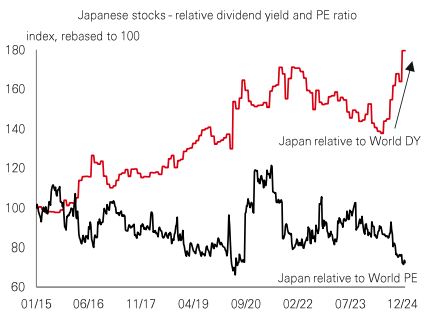
Chinese stocks delivered double-digit gains in 2024, with the market outperforming major regional neighbours like India and South Korea. That was largely driven by a leap in valuations after a fresh round of economic and market stimulus measures last September.
Yet, Chinese markets have been weak of late. Investors are fretting over headwinds ranging from lacklustre domestic demand and geopolitical risks to the strong US dollar and the prospect of tariffs. There is also uncertainty over the timing and scope of further domestic policy support.
On that front, parliamentary sessions in early March could see details on the 2025 growth and fiscal deficit target, the annual bond issuance quota, and other economic and social targets. Officials have already set a pro-growth policy tone for 2025. More demand-side stimulus, further efforts to stabilise the property sector, and structural reforms to rebalance the economy could support the growth outlook. For investors, Chinese stocks continue to trade at a discount despite analysts being optimistic on the profits outlook. Any positive news following the March meetings could boost sentiment and foreign inflows.
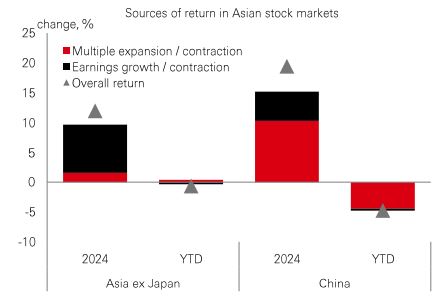
Past performance does not predict future returns. The level of yield is not guaranteed and may rise or fall in the future. For informational purposes only and should not be construed as a recommendation to invest in the specific country, product, strategy, sector, or security. Any views expressed were held at the time of preparation and are subject to change without notice. Any forecast, projection or target where provided is indicative only and is not guaranteed in any way. Index returns assume reinvestment of all distributions and do not reflect fees or expenses. Diversification does not ensure a profit or protect against loss. Source: HSBC Asset Management. Macrobond, Bloomberg, Datastream. Data as at 7.30am UK time 10 January 2025.

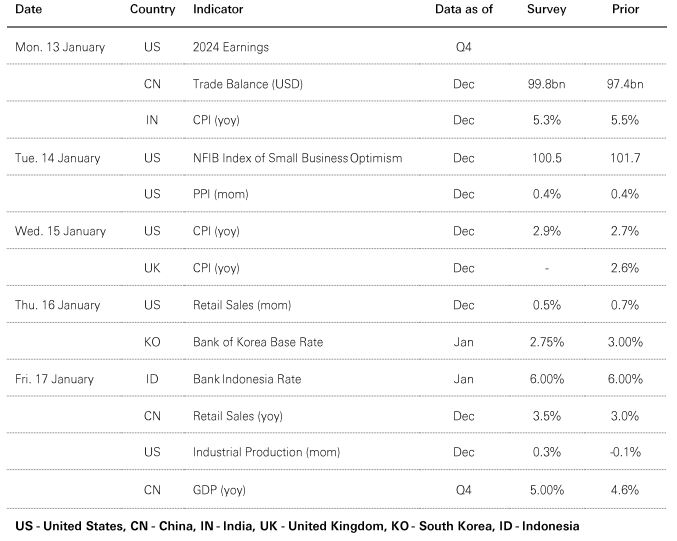
Source: HSBC Asset Management. Data as at 7.30am UK time 10 January 2025. For informational purposes only and should not be construed as a recommendation to invest in the specific country, product, strategy, sector or security. Any views expressed were held at the time of preparation and are subject to change without notice.
A widespread sell-off in core government bonds stifled risk markets amid ongoing uncertainty over US trade policy and the rate outlook. The US dollar continued to strengthen against major currencies. Gilts lagged behind Treasuries and Bunds due to rising UK fiscal concerns, with poor investor demand for the latest 30-year Gilt auction. US equities struggled to make headway ahead of the Q4 2024 earnings season. Europe’s Stoxx 50 index began the year on a positive note, but Japan’s Nikkei 225 tracked US stocks lower. In other Asian markets, Hong Kong’s Hang Seng fell, led by losses in some tech heavyweights on lingering worries over geopolitical tensions. Mainland China’s Shanghai Composite also slid, and earnings worries put pressure on India’s Sensex. Korea’s Kospi index bucked the trend, aided by stronger tech shares. In commodities, gold and copper advanced, while oil remained firm.






This document or video is prepared by The Hongkong and Shanghai Banking Corporation Limited (‘HBAP’), 1 Queen’s Road Central, Hong Kong. HBAP is incorporated in Hong Kong and is part of the HSBC Group. This document or video is distributed and/or made available, HSBC Bank (China) Company Limited, HSBC Bank (Singapore) Limited, HSBC Bank Middle East Limited (UAE), HSBC UK Bank Plc, HSBC Bank Malaysia Berhad (198401015221 (127776-V))/HSBC Amanah Malaysia Berhad (20080100642 1 (807705-X)), HSBC Bank (Taiwan) Limited, HSBC Bank plc, Jersey Branch, HSBC Bank plc, Guernsey Branch, HSBC Bank plc in the Isle of Man, HSBC Continental Europe, Greece, The Hongkong and Shanghai Banking Corporation Limited, India (HSBC India), HSBC Bank (Vietnam) Limited, PT Bank HSBC Indonesia (HBID), HSBC Bank (Uruguay) S.A. (HSBC Uruguay is authorised and oversought by Banco Central del Uruguay), HBAP Sri Lanka Branch, The Hongkong and Shanghai Banking Corporation Limited – Philippine Branch, HSBC Investment and Insurance Brokerage, Philippines Inc, and HSBC FinTech Services (Shanghai) Company Limited and HSBC Mexico, S.A. Multiple Banking Institution HSBC Financial Group (collectively, the “Distributors”) to their respective clients. This document or video is for general circulation and information purposes only.
The contents of this document or video may not be reproduced or further distributed to any person or entity, whether in whole or in part, for any purpose. This document or video must not be distributed in any jurisdiction where its distribution is unlawful. All non-authorised reproduction or use of this document or video will be the responsibility of the user and may lead to legal proceedings. The material contained in this document or video is for general information purposes only and does not constitute investment research or advice or a recommendation to buy or sell investments. Some of the statements contained in this document or video may be considered forward looking statements which provide current expectations or forecasts of future events. Such forward looking statements are not guarantees of future performance or events and involve risks and uncertainties. Actual results may differ materially from those described in such forward-looking statements as a result of various factors. HBAP and the Distributors do not undertake any obligation to update the forward-looking statements contained herein, or to update the reasons why actual results could differ from those projected in the forward-looking statements. This document or video has no contractual value and is not by any means intended as a solicitation, nor a recommendation for the purchase or sale of any financial instrument in any jurisdiction in which such an offer is not lawful. The views and opinions expressed are based on the HSBC Global Investment Committee at the time of preparation and are subject to change at any time. These views may not necessarily indicate HSBC Asset Management‘s current portfolios’ composition. Individual portfolios managed by HSBC Asset Management primarily reflect individual clients’ objectives, risk preferences, time horizon, and market liquidity.
The value of investments and the income from them can go down as well as up and investors may not get back the amount originally invested. Past performance contained in this document or video is not a reliable indicator of future performance whilst any forecasts, projections and simulations contained herein should not be relied upon as an indication of future results. Where overseas investments are held the rate of currency exchange may cause the value of such investments to go down as well as up. Investments in emerging markets are by their nature higher risk and potentially more volatile than those inherent in some established markets. Economies in emerging markets generally are heavily dependent upon international trade and, accordingly, have been and may continue to be affected adversely by trade barriers, exchange controls, managed adjustments in relative currency values and other protectionist measures imposed or negotiated by the countries with which they trade. These economies also have been and may continue to be affected adversely by economic conditions in the countries in which they trade. Investments are subject to market risks, read all investment related documents carefully.
This document or video provides a high-level overview of the recent economic environment and has been prepared for information purposes only. The views presented are those of HBAP and are based on HBAP’s global views and may not necessarily align with the Distributors’ local views. It has not been prepared in accordance with legal requirements designed to promote the independence of investment research and is not subject to any prohibition on dealing ahead of its dissemination. It is not intended to provide and should not be relied on for accounting, legal or tax advice. Before you make any investment decision, you may wish to consult an independent financial adviser. In the event that you choose not to seek advice from a financial adviser, you should carefully consider whether the investment product is suitable for you. You are advised to obtain appropriate professional advice where necessary.
The accuracy and/or completeness of any third-party information obtained from sources which we believe to be reliable might have not been independently verified, hence Customer must seek from several sources prior to making investment decision.
The following statement is only applicable to HSBC Mexico, S.A. Multiple Banking Institution HSBC Financial Group with regard to how the publication is distributed to its customers: This publication is distributed by Wealth Insights of HSBC México, and its objective is for informational purposes only and should not be interpreted as an offer or invitation to buy or sell any security related to financial instruments, investments or other financial product. This communication is not intended to contain an exhaustive description of the considerations that may be important in making a decision to make any change and/or modification to any product, and what is contained or reflected in this report does not constitute, and is not intended to constitute, nor should it be construed as advice, investment advice or a recommendation, offer or solicitation to buy or sell any service, product, security, merchandise, currency or any other asset.
Receiving parties should not consider this document as a substitute for their own judgment. The past performance of the securities or financial instruments mentioned herein is not necessarily indicative of future results. All information, as well as prices indicated, are subject to change without prior notice; Wealth Insights of HSBC Mexico is not obliged to update or keep it current or to give any notification in the event that the information presented here undergoes any update or change. The securities and investment products described herein may not be suitable for sale in all jurisdictions or may not be suitable for some categories of investors.
The information contained in this communication is derived from a variety of sources deemed reliable; however, its accuracy or completeness cannot be guaranteed. HSBC México will not be responsible for any loss or damage of any kind that may arise from transmission errors, inaccuracies, omissions, changes in market factors or conditions, or any other circumstance beyond the control of HSBC. Different HSBC legal entities may carry out distribution of Wealth Insights internationally in accordance with local regulatory requirements.
Important Information about the Hongkong and Shanghai Banking Corporation Limited, India (“HSBC India”)
HSBC India is a branch of The Hongkong and Shanghai Banking Corporation Limited. HSBC India is a distributor of mutual funds and referrer of investment products from third party entities registered and regulated in India. HSBC India does not distribute investment products to those persons who are either the citizens or residents of United States of America (USA), Canada or New Zealand or any other jurisdiction where such distribution would be contrary to law or regulation.
The following statement is only applicable to HSBC Bank (Taiwan) Limited with regard to how the publication is distributed to its customers: HSBC Bank (Taiwan) Limited (“the Bank”) shall fulfill the fiduciary duty act as a reasonable person once in exercising offering/conducting ordinary care in offering trust services/ business. However, the Bank disclaims any guarantee on the management or operation performance of the trust business.
The following statement is only applicable to PT Bank HSBC Indonesia (“HBID”): PT Bank HSBC Indonesia (“HBID”) is licensed and supervised by Indonesia Financial Services Authority (“OJK”).
Customer must understand that historical performance does not guarantee future performance. Investment product that are offered in HBID is third party products, HBID is a selling agent for third party product such as Mutual Fund and Bonds. HBID and HSBC Group (HSBC Holdings Plc and its subsidiaries and associates company or any of its branches) does not guarantee the underlying investment, principal or return on customer investment. Investment in Mutual Funds and Bonds is not covered by the deposit insurance program of the Indonesian Deposit Insurance Corporation (LPS).
Important information about ESG and Sustainable Investing
In broad terms "ESG and sustainable investing" products include investment approaches or instruments which consider environmental, social, governance and/or other sustainability factors to varying degrees. Certain instruments we classify as ESG or sustainable investing products may be in the process of changing to deliver sustainability outcomes. There is no guarantee that ESG and Sustainable investing products will produce returns similar to those which don’t have any ESG or sustainable characteristics. ESG and Sustainable investing products may diverge from traditional market benchmarks. In addition, there is no standard definition of, or measurement criteria for, ESG and Sustainable investing or the impact of ESG and Sustainable investing products. ESG and Sustainable investing and related impact measurement criteria are (a) highly subjective and (b) may vary significantly across and within sectors.
HSBC may rely on measurement criteria devised and reported by third party providers or issuers. HSBC does not always conduct its own specific due diligence in relation to measurement criteria. There is no guarantee: (a) that the nature of the ESG / sustainability impact or measurement criteria of an investment will be aligned with any particular investor’s sustainability goals; or (b) that the stated level or target level of ESG / sustainability impact will be achieved. ESG and Sustainable investing is an evolving area and new regulations and coverage are being developed which will affect how investments can be categorised or labelled. An investment which is considered to fulfil sustainable criteria today may not meet those criteria at some point in the future.
When we allocate an HSBC ESG and Sustainable Investing (SI) classification: HSBC ESG Enhanced, HSBC Thematic or HSBC Impact to an investment product, this does not mean that all individual underlying holdings in the investment product or portfolio individually qualify for the classification. Similarly, when we classify an equity or fixed income under an HSBC ESG Enhanced, HSBC Thematic or HSBC Impact category, this does not mean that the underlying issuer’s activities are fully aligned with the relevant ESG product or sustainable characteristics attributable to the classification. As such, an SI classification does not mean that all underlying holdings in a fund meet the relevant sustainable investment criteria. Not all investments, portfolios or services are eligible to be classified under our ESG and SI classifications. This may be because there is insufficient information available or because a particular investment product does not meet HSBC’s SI classifications criteria.
Today we finance a number of industries that significantly contribute to greenhouse gas emissions. We have a strategy to help our customers to reduce their emissions and to reduce our own. For more information visit www.hsbc.com/sustainability
HSBC may rely on measurement criteria devised and reported by third party providers or issuers. HSBC does not always conduct its own specific due diligence in relation to measurement criteria. There is no guarantee: (a) that the nature of the ESG / sustainability impact or measurement criteria of an investment will be aligned with any particular investor’s sustainability goals; or (b) that the stated level or target level of ESG / sustainability impact will be achieved. ESG and Sustainable investing is an evolving area and new regulations are being developed which will affect how investments can be categorised or labelled. An investment which is considered to fulfil sustainable criteria today may not meet those criteria at some point in the future.
THE CONTENTS OF THIS DOCUMENT OR VIDEO HAVE NOT BEEN REVIEWED BY ANY REGULATORY AUTHORITY IN HONG KONG OR ANY OTHER JURISDICTION.
YOU ARE ADVISED TO EXERCISE CAUTION IN RELATION TO THE INVESTMENT AND THIS DOCUMENT OR VIDEO. IF YOU ARE IN DOUBT ABOUT ANY OF THE CONTENTS OF THIS DOCUMENT OR VIDEO, YOU SHOULD OBTAIN INDEPENDENT PROFESSIONAL ADVICE.
© Copyright 2025. The Hongkong and Shanghai Banking Corporation Limited, A